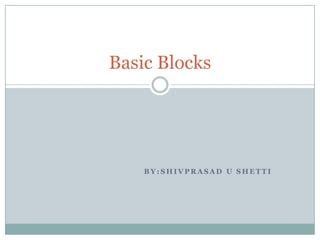
Basic Block
- 1. Basic Blocks BY:SHIVPRASAD U SHETTI
- 2. Three Address Code Three-address code (often abbreviated to TAC or 3AC) is an intermediate code used by compilers to aid in the implementation of code-improving transformations. Three Address Code is sequence of statements, typically of a general form A:= B op C, where A,B , and C are either programmer-Defined names, constants or compiler-generated temporary names; op stands for any operator, such as a fixed- or floating point arithmetic operator, or a logical operator on Boolean-valued data. The reason for the name “Three –address code” is that each statements usually contains three addresses, two for the operands and one for result. Example: Write a Three Address Code for following expression: “ X+Y*Z ” Solution: T1 := Y * Z T2 := X + T1 Where T1 and T2 are compiler-generated temporary names.
- 3. TAC Example Three Address Code Computing Dot product BEGIN 1) PROD :=0 2) I:=1 PROD := 0; I := 1; 3) T1 := 4*I 4) T2 := addr(A) – 4 DO BEGIN 5) T3 := T2[T1] /* Compute A[I] */ PROD :=PROD + A[I] *B[I]; 6) T4 := addr(B) - 4 I :=I+1 7) T5 := T4[T1] /* Compute END B[I] */ WHILE I ≤ 20 8) T6 := T3 * T5 END 9) PROD := PROD + T6 10) I := I+1 11) If I ≤ 20 goto (3)
- 4. Algorithm: Partition into Basic Blocks. Basic Blocks Input: A sequence of Three address statements. Our first step is to break the code Output: A list of basic blocks with each three of TAC Example in to basic address statement in exactly one block. blocks, that is sequence of Method: consecutive statements which may be 1) We first determine the set of leaders, the first statements of basic blocks the rules we use entered only at the beginning, and are as follow” when entered are executed in i) The first statement is a leader sequence without halt or possibility of ii) Any statement which is the target of a branch(except at the end of the basic conditional or unconditional goto is a block). leader iii) Any statement which immediately A useful algorithms for follows a conditional goto is a leader partitioning three address statements 2) For each leader construct its basic block, which consists of the leader and all the into basic blocks is the following statements up to but not including the next leader or the end of the program .Any statements not placed in a block can ever be executed and may now be removed, if desired.
- 5. Basic Block A basic block is a sequence of consecutive statements in which flow of control enters at the beginning and leaves at the end without halt or possibility of branching except at the end. The code in a basic block has: one entry point, meaning no code within it is the destination of a jump instruction anywhere in the program; one exit point, meaning only the last instruction can cause the program to begin executing code in a different basic block. A list of basic blocks with each three-address statement in exactly one block. Step 1. Identify the leaders in the code. Leaders are instructions which come under any of the following 3 categories : The first instruction is a leader. The target of a conditional or an unconditional goto/jump instruction is a leader. The instruction that immediately follows a conditional or an unconditional goto/jump instruction is a leader.
- 6. Step 2. Starting from a leader, the set of all following instructions until and not including the next leader is the basic block corresponding to the starting leader Thus every basic block has a leader.
- 7. BASIC BLOCKS A basic block is a sequence of consecutive statements in which flow of control enters at the beginning and leaves at the end without halt or possibility of branching except at the end. The following sequence of three-address statements forms a basic block: t1 := a*a t2 := a*b t3 := 2*t2 t4 := t1+t3 t5 := b*b t6 := t4+t5
- 8. A three-address statement x := y+z is said to define x and to use y or z. A name in a basic block is said to live at a given point if its value is used after that point in the program, perhaps in another basic block. The following algorithm can be used to partition a sequence of three-address statements into basic blocks.
- 9. Example 3: Consider the fragment of source code shown in fig. 7; it computes the dot product of two vectors a and b of length 20. A list of three- address statements performing this computation on our target machine is shown in fig. 8. begin prod := 0; i := 1; do begin prod := prod + a[i] * b[i]; i := i+1; end while i<= 20 end fig 7: program to compute dot product
- 10. Let us apply Algorithm 1 to the three-address code in fig 8 to determine its basic blocks. statement (1) is a leader by rule (I) and statement (3) is a leader by rule (II), since the last statement can jump to it. By rule (III) the statement following (12) is a leader. Therefore, statements (1) and (2) form a basic block. The remainder of the program beginning with statement (3) forms a second basic block. (1) prod := 0 (2) i := 1 (3) t1 := 4*i (4) t2 := a [ t1 ] (5) t3 := 4*i (6) t4 :=b [ t3 ] (7) t5 := t2*t4 (8) t6 := prod +t5 (9) prod := t6 (10) t7 := i+1 (11) i := t7 (12) if i<=20 goto (3) fig 8. Three-address code computing dot product
- 11. • PROD :=0 • B1 I := 1 T1:=4*I T2:=addr(A)-4 • T3:=T2[T1]B2 T4:=addr(B)-4 T5:=T4[T1] T6:=T3*T5 Prod:=PROD + T6 I:=I+1 If I<20 goto (3)